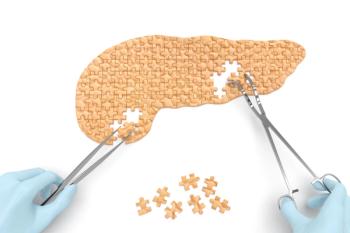
- Drug Topics October 2023
- Volume 167
- Issue 09
Quizartinib Approved for Newly Diagnosed AML in Patients with ITD
Overall median survival was higher in participants taking quizartinib, according to results from QuANTUM-First trial.
Acute myeloid leukemia (AML) is a heterogeneous disease, with the most frequently reported mutation being an internal tandem duplication (ITD) of FLT3. The standard treatment for patients with FLT3-ITD–positive AML consists of chemotherapy and allogenic hemopoietic cell transplantation. Despite these treatments, FLT3-ITD–positive AML generally has poor clinical outcomes and is associated with an increased risk of relapse and shorter overall survival.1
On July 20, 2023, the FDA approved quizartinib (Vanflyta) for adult patients with newly diagnosed AML that is FLT3- ITD positive.1 The oral, once daily, selective second-generation type 2 FLT3 inhibitor would be used with cytarabine and anthracycline induction and cytarabine consolidation, and as maintenance monotherapy following consolidation chemotherapy.2 Quizartinib is only available for prescribing through the restricted Vanflyta Risk Evaluation and Mitigation Strategies (REMS).2
Efficacy
QuANTUM-First (NCT02668653) was a phase 3, double-blind, placebo-controlled clinical trial that enrolled 539 patients aged 18 to 75 years with FLT3-ITD–positive AML.1 Participants underwent an initial 7 + 3 induction regimen with cytarabine infusion on days 1 to 7 and anthracycline infusion on days 1, 2, and 3. On day 7, patients were randomly assigned 1:1 to receive quizartinib 40 mg (n = 268) or placebo (n = 271) once daily for 14 days.1
On day 21, based on test results from a bone marrow specimen, patients with persistent leukemia could receive a second cycle of induction chemotherapy plus quizartinib or placebo. If they had entered complete remission, they could proceed to consolidation therapy. Consolidation therapy consisted of high-dose cytarabine plus quizartinib or placebo. Following induction and consolidation treatment, patients began continuation therapy of either quizartinib or placebo, receiving either drug for up to thirty-six 28-day cycles. The median exposure times were 10.71 and 9.50 weeks for quizartinib and placebo, respectively.1
Over the 3 years of the trial, 55% of patients in the quizartinib group and 62% in the placebo group discontinued the study due to death or withdrawal of consent. Overall median survival was 31.9 months for the quizartinib group vs 15.1 months for placebo (HR, 0.78; 95% CI. 0.62-0.98, P = .032). Similarly, relapse-free survival was more prolonged with quizartinib vs placebo (median, 39.3 vs 13.6 months; HR, 0.61; 95% CI, 0.44-0.85).2
Safety
The most common adverse events (AEs) reported across both groups included hypokalemia, febrile neutropenia, and pneumonia.3 One AE of note in the quizartinib group was corrected QT interval (QTc) prolongation; quizartinib has a black box warning for QT prolongation, torsade de pointes, and cardiac arrest. Because of this boxed warning, therapy should not be initiated in patients with a QTcF interval greater than 450 ms. As a safety precaution, an electrocardiogram should be performed before initiating therapy, and any electrolyte abnormalities should be corrected. Quizartinib is contraindicated for use in patients with a history of ventricular arrhythmias, torsade de pointes, severe hypokalemia, severe hypomagnesemia, and long QT syndrome.3
No renal dose adjustments are required in patients with mild to moderate renal or hepatic impairment. However, its effects on patients with severe renal impairments (CrCl less than 30 mL/min) and hepatic impairments (Child-Pugh Class C) have not been studied. For patients who are prescribed a strong CYP3A4 inhibitor, it is recommended that the quizartinib dose be reduced. Similarly, it is advised to avoid concomitant use with a strong or moderate CYP3A4 inducer.3
Dosing and Administration
Quizartinib is available in 17.7-mg and 26.5-mg oral tablets. Tablets are to be taken whole, once daily, at approximately the same time each day.3 Treatment courses with quizartinib consist of 2 cycles of induction therapy with cytarabine, anthracycline, and quizartinib; up to 4 cycles of high-dose cytarabine consolidation therapy with quizartinib’ and up to 36 cycles of quizartinib maintenance therapy.3
Melek Hursid, PharmD, MBA, is a PGY-1 pharmacy resident at John Dempsey Hospital/UConn Health in Farmington, Connecticut.
Kevin W. Chamberlin, PharmD, FASCP, is associate vice president and chief pharmacy officer at John Dempsey Hospital/UConn Health in Farmington, Connecticut.
References
1. Erba HP, Montesinos P, Kim HJ, et al; QuANTUM-First Study Group. Quizartinib plus chemotherapy in newly diagnosed patients with FLT3-internal-tandem-duplication-positive acute myeloid leukemia (QuANTUM-First): a randomized, double-blind, placebo-controlled, phase 3 trial. Lancet. 2023;401(10388):1571-1583. doi:10.1016/S0140- 6736(23)00464-6
2. FDA approves quizartinib for newly diagnosed acute myeloid leukemia. News release. FDA. Accessed September 12, 2023. https:// www.fda.gov/drugs/drug-approvals-and-databases/fda-approves-quizartinib-newly-diagnosed-acute-myeloid-leukemia
3. Vanflyta (quizartinib). Prescribing information. Daiichi Sankyo, Inc; 2023. Accessed September 12, 2023. https://www.accessdata.fda. gov/drugsatfda_docs/label/2023/216993s000lbl.pdf
Articles in this issue
about 2 years ago
Preventing Severe Respiratory Infections in Childrenabout 2 years ago
Pediatric T1D Management Adherence System Evaluatedabout 2 years ago
The ABCs of CBD: Cannabinoids in Dermatology and Skin Careabout 2 years ago
Sickle Cell Disease Finally Getting Its Dueabout 2 years ago
Vitamin Supplementation May Help Reduce Endometriosis Related Painabout 2 years ago
Celebrating Women in Pharmacyabout 2 years ago
Biosimilars Are Bringing Affordability and AccessibilityNewsletter
Pharmacy practice is always changing. Stay ahead of the curve with the Drug Topics newsletter and get the latest drug information, industry trends, and patient care tips.





















































































































































